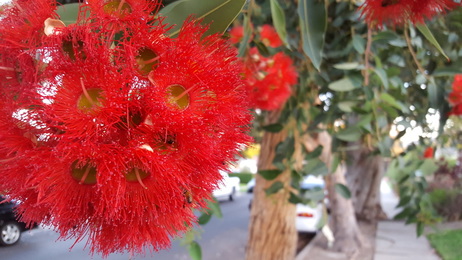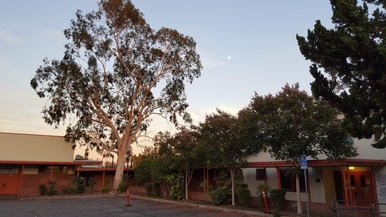 Eucalyptus trees along the freeway.
Eucalyptus trees along the freeway. Driving through Southern California, it's hard to miss the plethora of trees that zoom by on the side of the road. It's a little bit easier, though, not to notice just exactly how many of those trees are alien invaders. In fact, most of our decorative trees used in parks and around houses are non-native ornamental trees. One recognizable example of these foreign trees is the genus Eucalyptus. These are the tall, evergreen trees that can usually be seen on the side of the freeway or scattered throughout neighborhoods. Eucalyptus trees have a long history in California, first being planted in 1856, to fulfill the shade-desiring inhabitants of the tree-starved landscape. They grew hardily and fast, supposedly up to 40 feet in 6 years, not hindered by any of their natural pests.
 Some Eucalyptus flowers
Some Eucalyptus flowers These primarily Australian trees are often known as "gum trees" because of the sticky "gum" that they release when damaged. They can also be distinguished by their bark, which can often be pulled off in long strips and flakes, and by their distinctive flowers and fruits. There are about 600 species in the Eucalyptus genus and they can all be distinguished by these features.
 One of the Eucalyptus trees that we spotted during our trip.
One of the Eucalyptus trees that we spotted during our trip. Unfortunately for these Californian trees, they are no longer a stranger to their native pests. One of the prettiest examples is the Eucalyptus tortoise beetle. It made its way from down-under to Riverside County at some point pre-1998. Although these beetles can cause obvious feeding damage in the form of bites taken out of leaves, they haven't been known to kill or even particularly harm healthy trees. Another conspicuous Eucalyptus pest is the Redgum lerp psyllid. Immature stages of this psyllid forms white cone-shaped protective covering called lerps which can cause leaves to look unsightly although this pest by itself isn't enough to cause severe problems for trees. Some of the worst pests are the two species of Eucalyptus long-horned borer beetle that can take down entire trees, though biological control has been largely effective in reducing the numbers of at least one species.
 RSS Feed
RSS Feed
